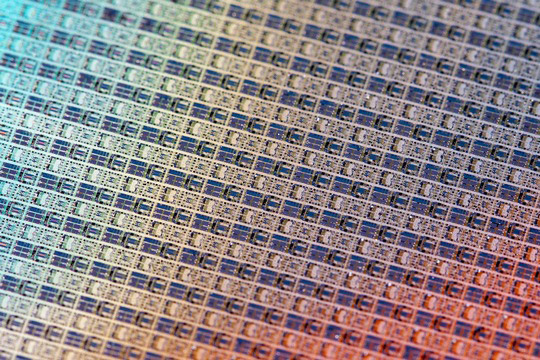News: Microelectronics
1 September 2021
AlScN project for energy-saving mobile radio base stations wins funding
In the innovation competition ‘Electronics for Energy-Saving Information and Communications Technology’ launched by the German Federal Ministry of Education and Research (BMBF), the Fraunhofer Institutes IAF (Institute for Applied Solid State Physics, in Freiburg) and IIS (Institute for Integrated Circuits, of Erlangen), together with the University of Freiburg/INATECH, have won second place (out of ten research teams) with their joint project proposal ‘EdgeLimit – Evaluation of Power Electronics in Modern Edge Cloud Systems’. The project consortium is funded by Germany’s Federal Ministry of Education and Research (BMBF) to realize their solution for energy-saving mobile radio base stations.
With the aim of promoting innovative solutions for energy-saving information and communication technologies (ICT), the BMBF launched the ‘Electronics for Energy-Saving ICT’ innovation competition last year as part of the ‘Green ICT’ initiative in its action plan ‘Natürlich.Digital.Nachhaltig.’ (a building block of the German Federal Government’s Climate Protection Program 2030). After winning second place, EdgeLimit will receive exclusive funding from the BMBF for realization of the project. All three winning teams can now submit their research project designed in the competition to the BMBF for further funding and will receive €12m for this purpose.

Picture: High-frequency amplifiers based on aluminium scandium nitride (AlScN) have the potential to significantly improve the power density and efficiency of high-frequency amplifiers in 5G base stations. © Fraunhofer IAF
“The resource consumption of advancing digitization is taking on ever greater dimensions. We must ensure through research and development that digitization becomes part of the solution in the fight against climate change and not part of the problem,” states Federal Research Minister Anja Karliczek. This is particularly true of information & communication technologies, which will have to become much more energy-efficient in the future. New key technologies and a shift in thinking toward demand-based performance requirements are needed for ICT, it is reckoned.
In their prize-winning preliminary project, the EdgeLimit consortium researched innovative semiconductor technologies and approaches towards more energy-efficient mobile communication antenna systems. New mobile communications systems achieve enormous increases in data rates, but the energy consumption of these systems must be reduced at least to the same extent.
EdgeLimit presents a concept for the use of novel power semiconductors for high-frequency amplifiers in 5G base stations for the new millimeter-wave frequency range at 26-34GHz based on aluminium scandium nitride (AlScN). It is reckoned that the project offers not only enormous potential savings in energy consumption and CO2 emissions but also an extraordinary level of innovation in high-frequency electronics, with major leverage for microelectronics in Germany. This finds expression in the significant participation of industry in the second phase of the project, with a planned cooperation with Nokia Bell Labs, United Monolithic Semiconductors GmbH, Deutsche Telekom AG (associated) and Nokia Solutions and Networks GmbH & Co KG.
More efficient antenna amplifiers
Modern networked ICT systems increasingly have capacities for collecting and processing information at the edge of the network in addition to the central data-processing infrastructures (cloud) as well as systems for transferring data between cloud and edge. “Our goal is to realize a complete antenna system, a so-called remote radio head (RRH), which will enable more energy-efficient transmission in the millimeter-wave range of 5G while halving losses at the same time,” says project coordinator Rüdiger Quay, deputy director of Fraunhofer IAF and professor for Energy-Efficient Radio-Frequency Electronics.
“We are working, for example, on intelligent edge solutions that take energy consumption into account during the design phase and reduce it to a minimum,” says professor Albert Heuberger, director of Fraunhofer IIS. By looking at the energy consumption of the radio units (massive MIMO antennas) in the 5G Testbed Industry 4.0 at Fraunhofer IIS, energy-efficient, distributed, secure edge cloud systems can be built and tested.
The project partners are using the novel power semiconductor AlScN to develop pioneering high-frequency components. “The semiconductor technology we are pursuing, with which we have already gained a lot of experience at IAF, has the potential to fundamentally increase power efficiency in integrated circuits (MMICs) through better matching, higher gain and higher power density,” says Quay. Due to its high current-carrying capacity, AlScN allows significant advantages over established semiconductors such as silicon, gallium arsenide (GaAs) and AlGaN/GaN. Based on this material, EdgeLimit aims to at least double power efficiency at the amplifier level in new cellular frequencies as well as to halve losses in power converters.
Intelligent and demand-oriented ICT
More energy-efficient electronics alone cannot counter the exponentially increasing energy consumption of ICT. The horizon of physical energy efficiency is closer than that of the realizable data throughput, which is growing faster and thus producing a rebound effect. One solution is the intelligent and adaptive management of mobile communications systems, which ensures that energy is used as needed—an approach with enormous energy-saving potential.
To enable smart ICT, innovative power electronics architectures are required that allow electronics to be switched on and off as needed without compromising the latency of data transmissions. “At the network level, large amounts of energy should be saved by intelligently networking transmission modules and antennas with on-demand control, for example in factory networks such as the new Bosch semiconductor fab in Dresden or for fast video transmission to cars,” says Quay. “For this purpose, we are developing the necessary high-frequency electronics in EdgeLimit that are capable of being connected to intelligent network management. Because one thing is certain: in the further development of ICT, we must give resource efficiency at least the same priority as performance enhancement. This is the only way to reduce CO2 emissions as digitization advances.”
HEMTs from AlScN-barrier MOCVD
Fraunhofer IAF claims first MOCVD production of AlScN layers for transistors








